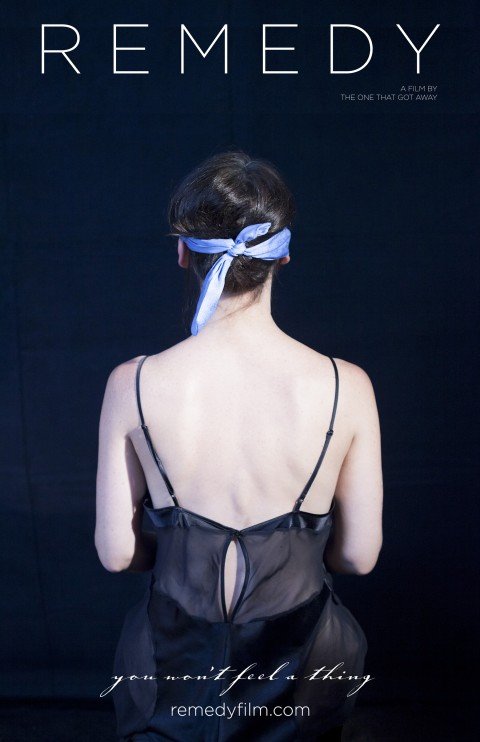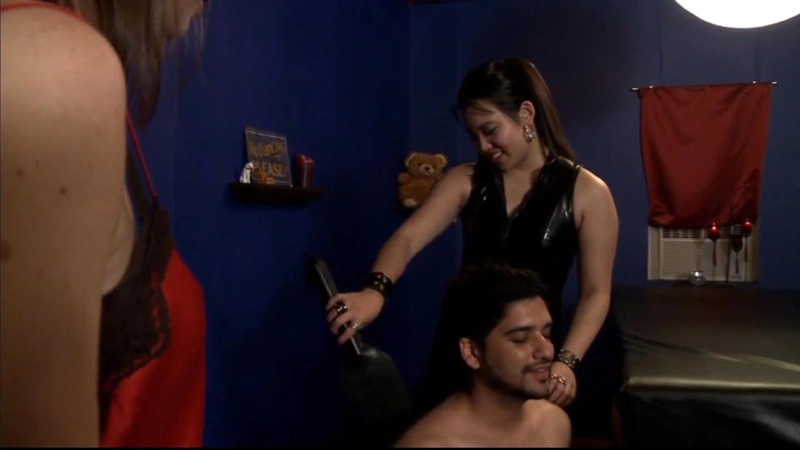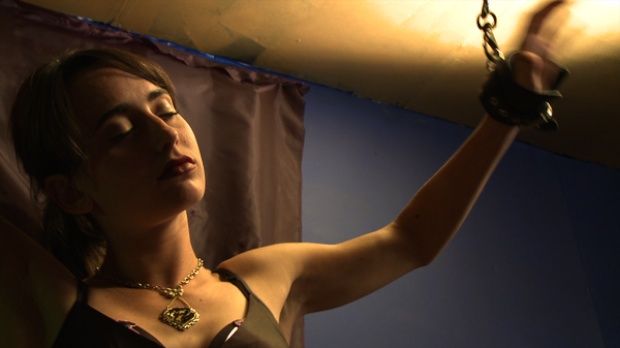
Remedy is a 2013 drama directed by Cheyenne Picardo and written by Picardo et al.
A young woman known only by her nomme de domme, Remedy (Kira Davies), explores the world of professional domination and submission. She has some experience with BDSM at a night club, where she met a woman named Astrid, who hooked her up with a dungeon in NYC. Her motivation isn’t clear, whether it’s money or something else. (She has an unseen boyfriend and works as a children’s tutor.)
Compared to films like My Normal, Remedy is a lot less glamorous in its depiction of this kind of sex work. The dungeon space is more cluttered and claustrophobic, and some of bondage furniture is unsafe and “just for show.” The women Remedy works with are less conventionally pretty. One tells a story about a scene that went disastrously wrong and they dumped the client in a wheelchair a few blocks away and called 911. Remedy argues with the manager about being a switch or

The men Remedy sees are a rogue’s gallery of the weird, the vulnerable, the obnoxious, and the outright threatening. One asks her to pull out his teeth. Another wants her to be his secretary as he goes on a rant about fixing all the world’s problems. A third, Jewish man tries to goad her into an anti-Semitic raceplay scene. Remedy seems less like a sex goddess and more like a baby sitter for overindulged children.
The requests themselves are less of a problem than the tension between Remedy’s limits and her clients’ desires; they often want more than she’s willing to give. This may be inherent to the sex worker/client dynamic: the clients are trying to get as much as possible for their money, and the SWers are trying to do as little as possible. Even the submissives are trying to get the upper hand in the transaction.
A few of the men seem like okay guys, but their interactions with Remedy don’t follow the standard mistress/client script. She tries to do a bondage session with one guy, but he easily shrugs out of it, then coaches her on tying him up, then she lets him tie her up to explain bondage to her. After she flogs another guy, she lets him put her in the bondage cuffs. The first time she does a sub scene with a client, she gets deeper into it than she expected. Another dominant client leaves her in shock.

This is Remedy’s problem: whether the men are threatening or seductive, dom or sub, they’re not supposed to get past her boundaries. She’s supposed to be in control, of herself and of them. Instead, her genuine emotions come out, both masochistic and sadistic. Films like Personal Services and My Normal show pro dommes as always in control, never getting too intimate with their clients. Others, like Remedy, Dogs Don’t Wear Pants and Going Under, show what happens when those boundaries are breached, usually for the worse.
If Remedy’s motivation is self-knowledge about her own sexuality, why did she have to become a pro domme? By her own account, Remedy’s first direct exposure to BDSM was at a nightclub, so she knows that there is a non-commercial BDSM scene. It’s reminiscent of how Severine in Belle de Jour worked at a brothel as a means to reactivate her sexuality instead of just picking up men. It may be she wants the distance that comes with the commercial transaction. But just as the chaotic Marcel follows Severine home, Remedy’s own feelings don’t stay contained.
As I’ve pointed out before, there are far more professional female dominants in mainstream media than non-professionals. Pro domination is certainly an interesting area to explore, but it isn’t the same as non-commercial femdom/malesub relationships. The power dynamics are very different once you remove money from the equation. However, I think many people honestly can’t conceive of a non-professional female dominant.

I had found Remedy mentioned on lists of BDSM movies, but I couldn’t find it streaming anywhere, or even a DVD release. The director, Cheyenne Picardo, said she was working to get her film on DVD, and was kind enough to give me a closed streaming link. This illustrates a trend I find troubling.
Vito Russo published the first edition of The Celluloid Closet in 1981. When I read it, I was impressed that Russo had manged to study so many old and obscure films before the home video revolution, which must have involved traveling to film archives and the like. He couldn’t just order the videocassette or laserdisc.
My research has been a lot easier than his, though it has been a struggle to find older and more obscure works. The existence of a market for used video media has been a boon.
More than 40 years later after Closet was published, online streaming is fast becoming the main way people view film and television. Everything is under control of the streaming platforms, and sometimes there is no physical media release at all. That means if the powers don’t be want a work of media in the public, whether from censorship or just neglect, they just take it off the streaming server. There’s no physical media out in the world, to be sold, re-sold, traded, collected, etc. You can’t even record it from broadcast onto a blank tape the way people used to.
This puts the control of what people watch back in hands of media corporations, just like the pre-home-video era. An independent production like Remedy may be too edgy in its sexuality to stream on a platform like Netflix, and not commercially viable for a home video release. Even free-with-ads streaming platforms like Tubi might not take it. It becomes lost, unavailable to viewers both present and future.




[…] is streaming a series of BDSM films and documentaries for queer history month, including Remedy (2013), Bloodsisters (1995), Thee Debauchery Ball: Director’s Cut (2022), The Secret Love Life of […]